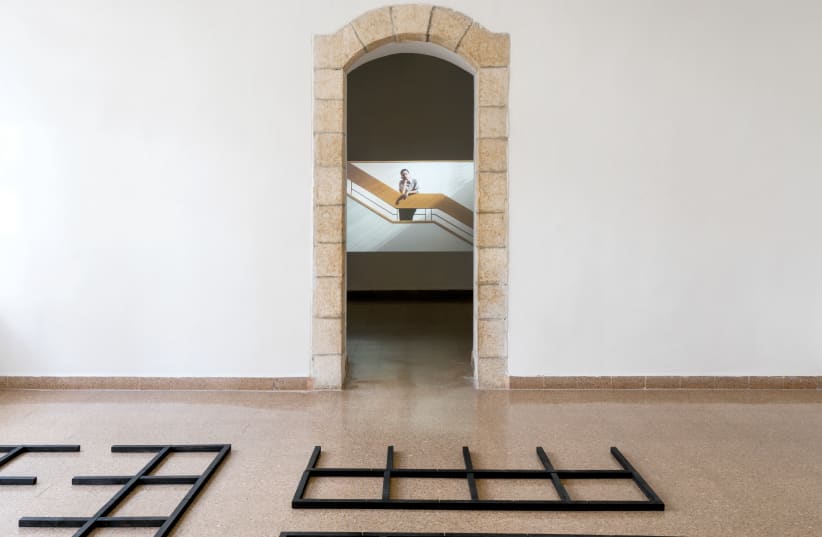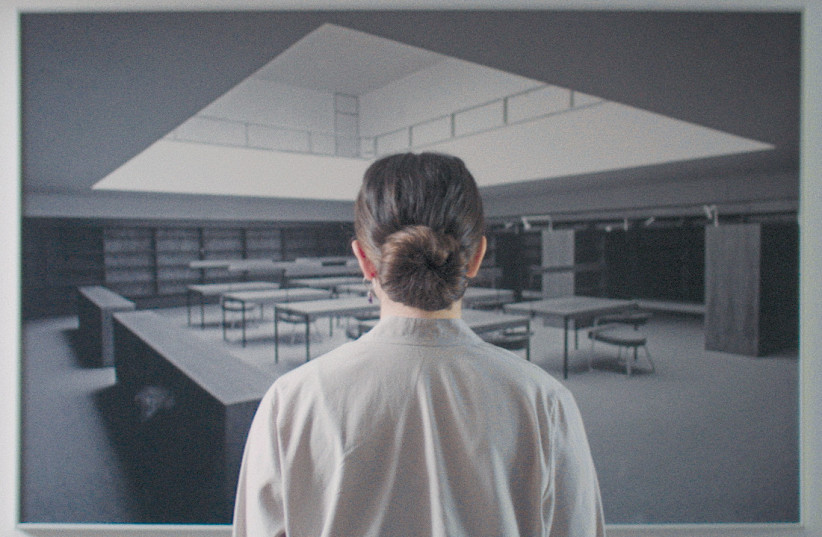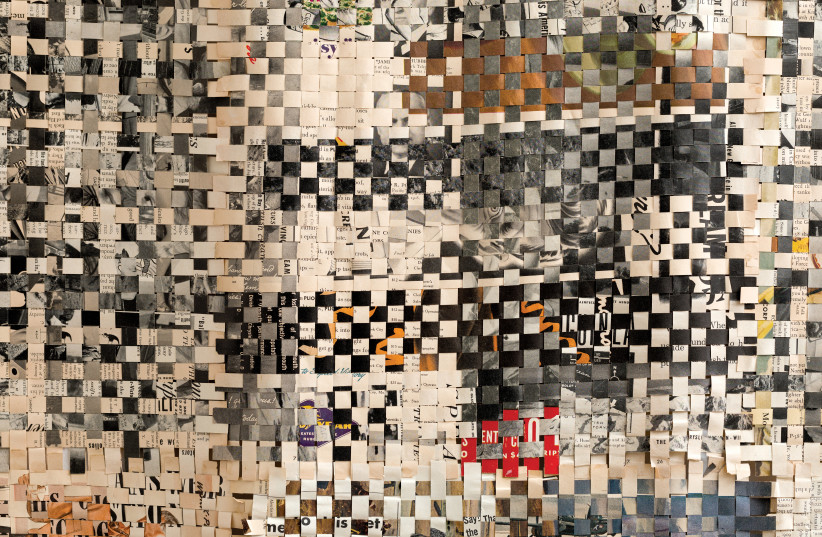When is a library not a library?
That’s quite a dome scratcher, even in this virtual universe of ours in which we use an ever-growing glossary of terms originally associated with a definitively tactile domain to denote the assertion of actual corporeal structures. Words such as “construction” come to mind, used to indicate the creation of a website which, after all, is not a tangible brick-and-mortar entity. Then again, if we cast our minds back to the not too distant past we all inescapably recall, however hard we may try to forget, that our own four walls took on a very different complexion during last year’s spate of lockdowns. An Englishman’s home is his castle is a saying which applies equally to the world outside England, but as COVID-19 ministerial constraints increasingly cut into our freedom of movement, that proverbial refuge became more of a prison.
That line of thinking is central to a compelling video work by Renana Aldor, which is currently on looped show at the Jerusalem Artists’ House. The thirty-something multidisciplinary artist recently added a feather to her beret when her site-specific creation “The Library” was awarded the prestigious annual Miron Sima Prize for Visual Art. In its grounds for conferring the kudos on Aldor, the committee observed that the artist “orchestrates places, objects, and human actions, both analytical and fantastic, furnishing viewers with an experience of beauty, imagination, and inspiration.”
“The Library” forms part of an installation that occupies three rooms on the second floor of the Jerusalem Artists House and comes with the pretty wordy title “The Space, the Period, the Comma, the Twenty-two Letters.” The Hebrew moniker, naturally, is far more compact. “It is called ‘Twenty-Five Syllables’,” Aldor notes, adding: “That’s the 22 Hebrew letters, plus the comma, space and period.”
The lingual nuts and bolts inform the entire spread, curated by Hadas Maor, particularly the corporeality, the extra-screen and the furnishings, which take the form of vertical shelf ends. In the room next to the screening space they are laid out horizontally on the floor, with more attached to the walls, and standing freestyle and looking a little like hat-umbrella stands in the third area. The fundamentally skeletal nature of the black units is underscored by the bright white walls and ceiling.
When I pointed out to Aldor that the numerical alphabetical total does not work in English, as the English alphabet contains 26 letters. She explained that one of the inspirations for her award-winning video was the Spanish-language short story The Library of Babel by 20th century Argentine author and librarian Jorge Luis Borges. “He relates to an alphabet of 22 letters in the book,” she says. “That is very interesting. I tried to understand where he got that from.”
Be that character aspect as it may, the spirit of the Borges tome pervades the entire “Twenty-Five Syllables” work, as Aldor considers the essence of literary climes, and how we view the relevant environs and repository.
The video work is very much an extension of the 1941 publication in which Borges describes an enormous library with a vast number of books. However, while the quantity may be impressive, it does not necessarily guarantee quality content. In fact, the majority of the items on the shelves are full of gibberish, but does that mean they are worthless? Borges suggests that it is not necessarily the way the constituent parts are crafted into a cohesive or disjointed flow, but more of a matter of adopting a deconstructionist view and relating to the individual components. He posits that perhaps everything that was ever written and might be written anytime in the future could be devised using any or all of the base script elements.
Aldor conveys that idea in the film, as well as the COVID-fueled physical surroundings rethink, which features an actress making her way around the library of the Van Leer Jerusalem Institute, which we are told has changed little in the close to half a century since it was built. It is comforting to know that in these volatile times there are some things that remain constant. The artist sees the time capsule library as something of a nature reserve in which she invites us to tarry, reimagine and take onboard as an actual living breathing creature. The woman in the video explores her spatial possibilities, and delves into the filing cabinets and books on the shelves, digging below the surface, much in the way archeologists attempt to unearth and reassemble the past.
“The film enabled me to look at the place through different eyes,” Aldor says. “The architectural moment also represents some sort of emotional domain within [the library] and I can look at it.” That leads straight onto the pandemic home-base-confinement scenario. “It is a physical and imagined space. But it has different places that are not visible, and which I can only see by means of this work.”
As many artists have observed over the past couple of years, not being able to get out and about physically during the lockdowns not only forced them to reexamine their home patch, it also got them to look inward, into their own conscious, subconscious and accrued life experiences, and to feed off their inner world. Surely that is an indispensable requirement of anyone embarking on a creative venture, but the global health scare developments palpably and unavoidably accentuated that.
The evident-subliminal complementary balancing act is also central to “The Library”. The camera meanders through unlit and illuminated areas in a way that allows us to take books we have perceived on the shelves with us into the dark spots where little can be seen. “There is the movement. We can complete what we can’t really see,” Aldor notes.
It transpires that the artist attended the Jerusalem Adam Waldorf School, which follows the anthroposophy school of thought. Students of kindergarten age and in the younger classes often skimp on visual details and are allowed to complete a picture by exercising their imaginations. “Maybe that is part of it,” Aldor laughs.
Anthroposophy notwithstanding, Aldor’s polysyllabic offering draws in the eye and soul, and leaves one with nutritional food for thought.
LOCKDOWN FALLOUT pulsates through Chaya Ruckin Berkman’s “Which Overnight” sculpture-video exhibition, curated by Tal Broitman, which “offers a look into art created in the domestic, personal sphere”. There are plenty of maternal-female references, which we are told feed off Berkman’s preoccupation with universal questions regarding origin and meaning.
She employs a wide range of materials and textures, including snippets of pages taken from her Life magazine hoard from World War II. Berkman was intrigued by the oxymoronic interface between everyday consumerism set against global violence. “I find it very upsetting that while the horrors of war were taking place you find an ad for Coca-Cola in Life magazine. That, for me, is a troubling paradox.” The contextual irony of the publication title didn’t escape her either. “You have life, and all the death of war.”
That is most evident in the outsized “Europe Wall” work, which is clearly a highly labor-intensive undertaking. It comprises thousands of small strips of Life magazine pages sewn together in an interwoven dovetail format. “It took me about six months to make that,” Berkman says.
The mysterious exhibition title has a biblical origin and echoes something of the essence of the Aldor work. “‘Which Overnight’ talks about the castor oil plant (Ricinus communis) and the belly,” Berkman explains. The former infers the vegetation God bestowed upon Jonah the prophet to provide him with some shade, and which He summarily caused to wither and die. The belly was where Jonah found himself, deep inside the innards of the whale, after trying to avoid having to read the riot act to the evil inhabitants of Nineveh.
The transitory titular content can go various ways. “It is like Jonah’s shade, which sprang up and then vanished just as quickly,” says the artist. “It is also like when a baby is born. Nine months go by and suddenly the baby comes out. Works of art can also be born like that.”
The idea of impermanence also surfaces in the “Ricinus Shadow” leaf-shaped copper and corrosion work. “That’s the castor oil plant, of copper and rust. That’s for me to sit inside.” Pregnancy also pops up in Berkman’s rollout, as she feeds off her religious upbringing. “I struggle with the brainwashing I grew up on: national-religious thinking. In my work I look at God’s promises, say, of the Jews becoming so abundant, like the fish in the sea, that we will become infinite. I grew up with the idea of the goal just being to keep on going, to maintain life. It is not about living well.”
That tension of the artist’s baggage and where she is at today, her existential concerns and her drive to create are all in there.
THERE IS plenty in the way of friction dynamics in Yinon Avior’s print-based showing Stacks, as he presents us with all manner of waste material and the minutiae of quotidian existence that we generally prefer to ignore and neatly discard.
Avior’s works reference various body fluids and reflect the amalgam of materials in which he wallows and from which he duly emerges. He mines life’s substrata, as he duplicates and reprints substances that are normally sidestepped in polite company.
The definitively organic aspect of “Stacks” also comes through in the drawings on thermal paper that change color as they encounter heat and remember the act of drawing. As curator Bar Yerushalmi puts it: “This exhibition is preserved testimony to the aroused breathing body: the body that tests and tastes, licking the grimy substance of life from which it is made and to which it will return.”
The display space on the ground floor traditionally proffers the fruits of young artists, as part of the “Nidbach” series. As such, the visitor benefits from a glimpse of where current artistic creation may be headed.
Tom Maor’s “Mashpech – Funnel or Watering Can” arrangement, curated by Ayala Landow, also has subtextual import. He says there is some therapy to be had along the way too. “It feels a little infantile toward myself, but also part of a self-healing process.”
Once again, the memory of lockdowns rears its challenging head. Like the rest of us, Maor had plenty of time to study his proverbial navel, as his video item clearly imparts. We see the artist in his birthday suit gradually and introspectively applying layers of a creamy substance to himself.
The thematic “Funnel or Watering Can” work intimates the incessant flow of life, which at the end of the day never really changes. “There are lots of loops here and in life,” he observes. That circular dynamic can be comforting and unsettling in equal parts.
The exhibitions close on February 26. For more details, visit: www.art.org.il


